Principles and Procedures of RIDDOR for Castleford Company
VerifiedAdded on 2023/01/23
|6
|1756
|38
Report
AI Summary
This report examines the principles and procedures of recording and reporting accidents, diseases, and dangerous occurrences under RIDDOR (Reporting of Injuries, Diseases and Dangerous Occurrences Regulation 1995), focusing on the context of Castleford Manufacturing. It outlines the legal obligations and principles, including the requirement to report accidents causing more than three days of absence and to maintain records for a minimum of three years. The report details the procedure for recording accidents, dangerous occurrences, and near misses, emphasizing the importance of immediate reporting, accident book documentation, and alerting the Health and Safety Executive (HSE). It highlights the role of risk assessment in preventing future incidents and emphasizes the need for continuous improvement in workplace safety. The report concludes by underscoring the significance of adhering to HSE and RIDDOR regulations to minimize accidents and enhance overall productivity.
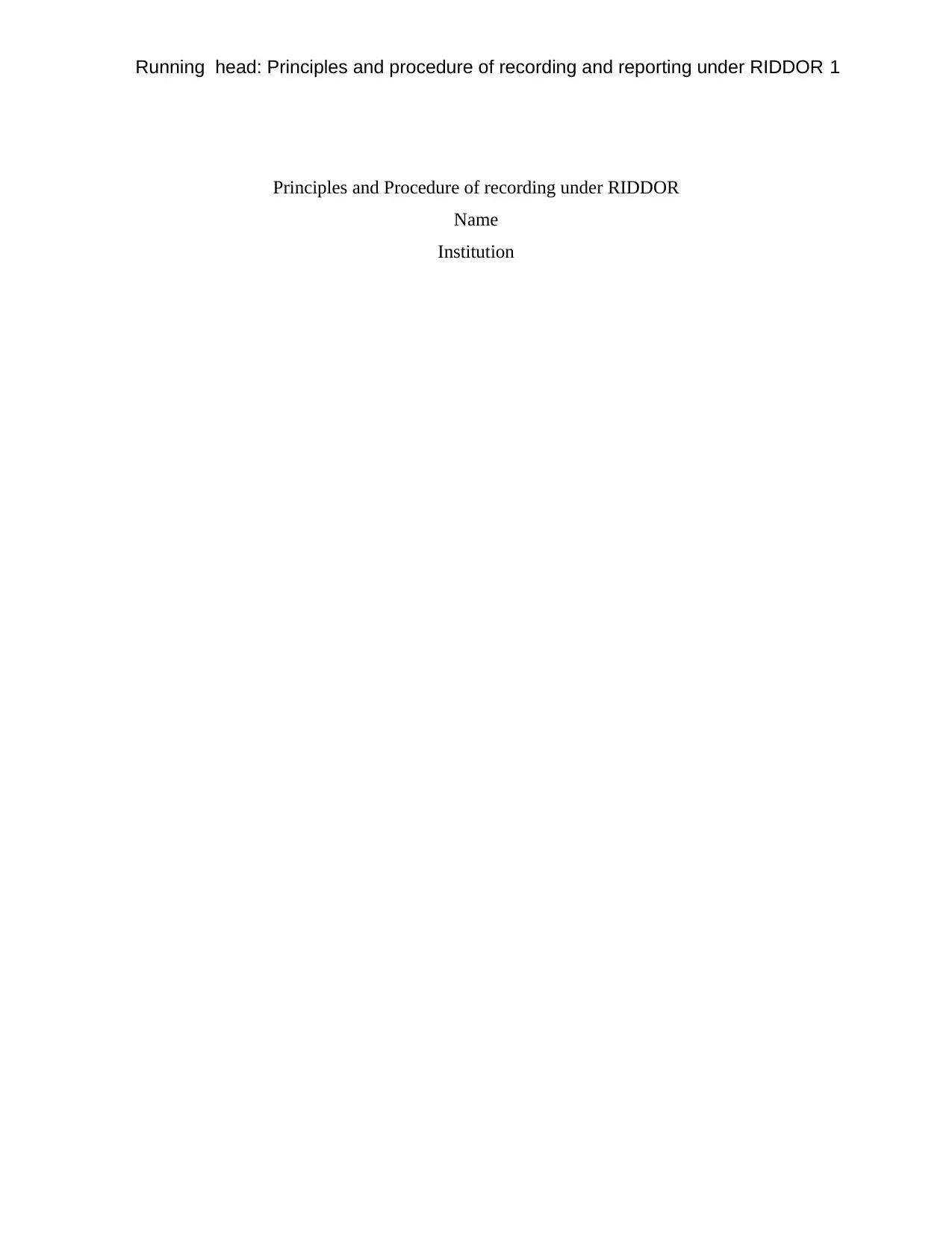
Running head: Principles and procedure of recording and reporting under RIDDOR 1
Principles and Procedure of recording under RIDDOR
Name
Institution
Principles and Procedure of recording under RIDDOR
Name
Institution
Paraphrase This Document
Need a fresh take? Get an instant paraphrase of this document with our AI Paraphraser
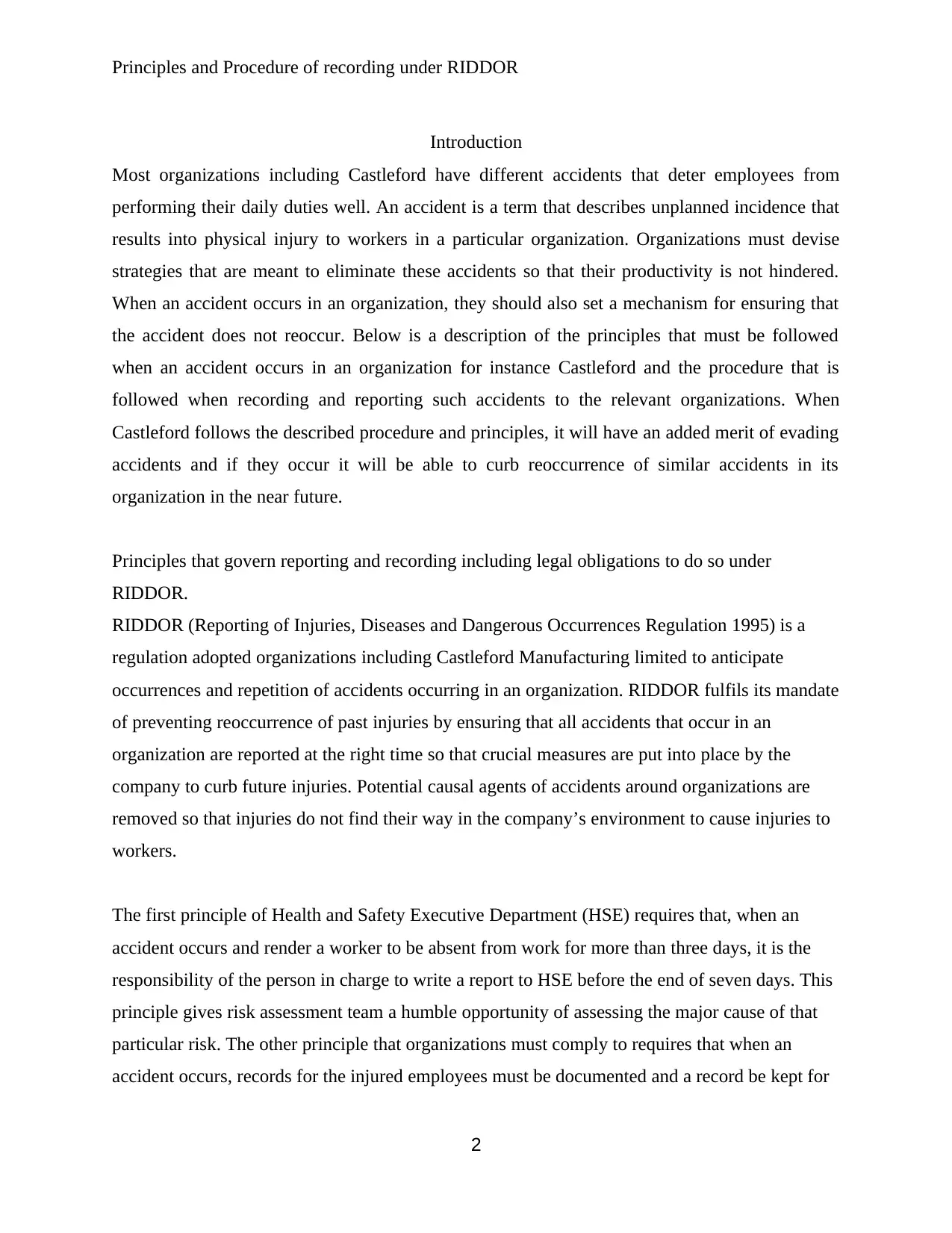
Principles and Procedure of recording under RIDDOR
Introduction
Most organizations including Castleford have different accidents that deter employees from
performing their daily duties well. An accident is a term that describes unplanned incidence that
results into physical injury to workers in a particular organization. Organizations must devise
strategies that are meant to eliminate these accidents so that their productivity is not hindered.
When an accident occurs in an organization, they should also set a mechanism for ensuring that
the accident does not reoccur. Below is a description of the principles that must be followed
when an accident occurs in an organization for instance Castleford and the procedure that is
followed when recording and reporting such accidents to the relevant organizations. When
Castleford follows the described procedure and principles, it will have an added merit of evading
accidents and if they occur it will be able to curb reoccurrence of similar accidents in its
organization in the near future.
Principles that govern reporting and recording including legal obligations to do so under
RIDDOR.
RIDDOR (Reporting of Injuries, Diseases and Dangerous Occurrences Regulation 1995) is a
regulation adopted organizations including Castleford Manufacturing limited to anticipate
occurrences and repetition of accidents occurring in an organization. RIDDOR fulfils its mandate
of preventing reoccurrence of past injuries by ensuring that all accidents that occur in an
organization are reported at the right time so that crucial measures are put into place by the
company to curb future injuries. Potential causal agents of accidents around organizations are
removed so that injuries do not find their way in the company’s environment to cause injuries to
workers.
The first principle of Health and Safety Executive Department (HSE) requires that, when an
accident occurs and render a worker to be absent from work for more than three days, it is the
responsibility of the person in charge to write a report to HSE before the end of seven days. This
principle gives risk assessment team a humble opportunity of assessing the major cause of that
particular risk. The other principle that organizations must comply to requires that when an
accident occurs, records for the injured employees must be documented and a record be kept for
2
Introduction
Most organizations including Castleford have different accidents that deter employees from
performing their daily duties well. An accident is a term that describes unplanned incidence that
results into physical injury to workers in a particular organization. Organizations must devise
strategies that are meant to eliminate these accidents so that their productivity is not hindered.
When an accident occurs in an organization, they should also set a mechanism for ensuring that
the accident does not reoccur. Below is a description of the principles that must be followed
when an accident occurs in an organization for instance Castleford and the procedure that is
followed when recording and reporting such accidents to the relevant organizations. When
Castleford follows the described procedure and principles, it will have an added merit of evading
accidents and if they occur it will be able to curb reoccurrence of similar accidents in its
organization in the near future.
Principles that govern reporting and recording including legal obligations to do so under
RIDDOR.
RIDDOR (Reporting of Injuries, Diseases and Dangerous Occurrences Regulation 1995) is a
regulation adopted organizations including Castleford Manufacturing limited to anticipate
occurrences and repetition of accidents occurring in an organization. RIDDOR fulfils its mandate
of preventing reoccurrence of past injuries by ensuring that all accidents that occur in an
organization are reported at the right time so that crucial measures are put into place by the
company to curb future injuries. Potential causal agents of accidents around organizations are
removed so that injuries do not find their way in the company’s environment to cause injuries to
workers.
The first principle of Health and Safety Executive Department (HSE) requires that, when an
accident occurs and render a worker to be absent from work for more than three days, it is the
responsibility of the person in charge to write a report to HSE before the end of seven days. This
principle gives risk assessment team a humble opportunity of assessing the major cause of that
particular risk. The other principle that organizations must comply to requires that when an
accident occurs, records for the injured employees must be documented and a record be kept for
2
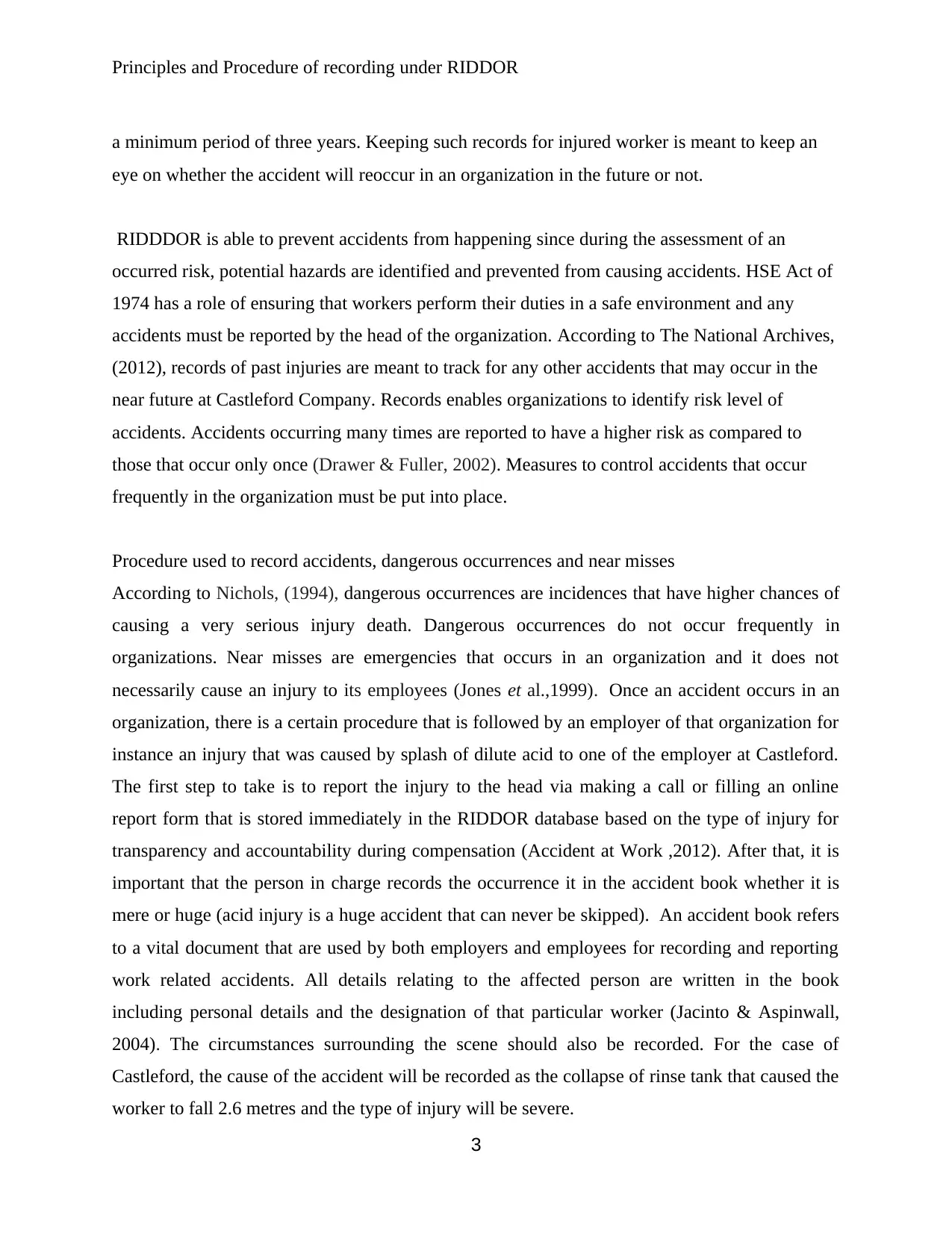
Principles and Procedure of recording under RIDDOR
a minimum period of three years. Keeping such records for injured worker is meant to keep an
eye on whether the accident will reoccur in an organization in the future or not.
RIDDDOR is able to prevent accidents from happening since during the assessment of an
occurred risk, potential hazards are identified and prevented from causing accidents. HSE Act of
1974 has a role of ensuring that workers perform their duties in a safe environment and any
accidents must be reported by the head of the organization. According to The National Archives,
(2012), records of past injuries are meant to track for any other accidents that may occur in the
near future at Castleford Company. Records enables organizations to identify risk level of
accidents. Accidents occurring many times are reported to have a higher risk as compared to
those that occur only once (Drawer & Fuller, 2002). Measures to control accidents that occur
frequently in the organization must be put into place.
Procedure used to record accidents, dangerous occurrences and near misses
According to Nichols, (1994), dangerous occurrences are incidences that have higher chances of
causing a very serious injury death. Dangerous occurrences do not occur frequently in
organizations. Near misses are emergencies that occurs in an organization and it does not
necessarily cause an injury to its employees (Jones et al.,1999). Once an accident occurs in an
organization, there is a certain procedure that is followed by an employer of that organization for
instance an injury that was caused by splash of dilute acid to one of the employer at Castleford.
The first step to take is to report the injury to the head via making a call or filling an online
report form that is stored immediately in the RIDDOR database based on the type of injury for
transparency and accountability during compensation (Accident at Work ,2012). After that, it is
important that the person in charge records the occurrence it in the accident book whether it is
mere or huge (acid injury is a huge accident that can never be skipped). An accident book refers
to a vital document that are used by both employers and employees for recording and reporting
work related accidents. All details relating to the affected person are written in the book
including personal details and the designation of that particular worker (Jacinto & Aspinwall,
2004). The circumstances surrounding the scene should also be recorded. For the case of
Castleford, the cause of the accident will be recorded as the collapse of rinse tank that caused the
worker to fall 2.6 metres and the type of injury will be severe.
3
a minimum period of three years. Keeping such records for injured worker is meant to keep an
eye on whether the accident will reoccur in an organization in the future or not.
RIDDDOR is able to prevent accidents from happening since during the assessment of an
occurred risk, potential hazards are identified and prevented from causing accidents. HSE Act of
1974 has a role of ensuring that workers perform their duties in a safe environment and any
accidents must be reported by the head of the organization. According to The National Archives,
(2012), records of past injuries are meant to track for any other accidents that may occur in the
near future at Castleford Company. Records enables organizations to identify risk level of
accidents. Accidents occurring many times are reported to have a higher risk as compared to
those that occur only once (Drawer & Fuller, 2002). Measures to control accidents that occur
frequently in the organization must be put into place.
Procedure used to record accidents, dangerous occurrences and near misses
According to Nichols, (1994), dangerous occurrences are incidences that have higher chances of
causing a very serious injury death. Dangerous occurrences do not occur frequently in
organizations. Near misses are emergencies that occurs in an organization and it does not
necessarily cause an injury to its employees (Jones et al.,1999). Once an accident occurs in an
organization, there is a certain procedure that is followed by an employer of that organization for
instance an injury that was caused by splash of dilute acid to one of the employer at Castleford.
The first step to take is to report the injury to the head via making a call or filling an online
report form that is stored immediately in the RIDDOR database based on the type of injury for
transparency and accountability during compensation (Accident at Work ,2012). After that, it is
important that the person in charge records the occurrence it in the accident book whether it is
mere or huge (acid injury is a huge accident that can never be skipped). An accident book refers
to a vital document that are used by both employers and employees for recording and reporting
work related accidents. All details relating to the affected person are written in the book
including personal details and the designation of that particular worker (Jacinto & Aspinwall,
2004). The circumstances surrounding the scene should also be recorded. For the case of
Castleford, the cause of the accident will be recorded as the collapse of rinse tank that caused the
worker to fall 2.6 metres and the type of injury will be severe.
3
⊘ This is a preview!⊘
Do you want full access?
Subscribe today to unlock all pages.

Trusted by 1+ million students worldwide
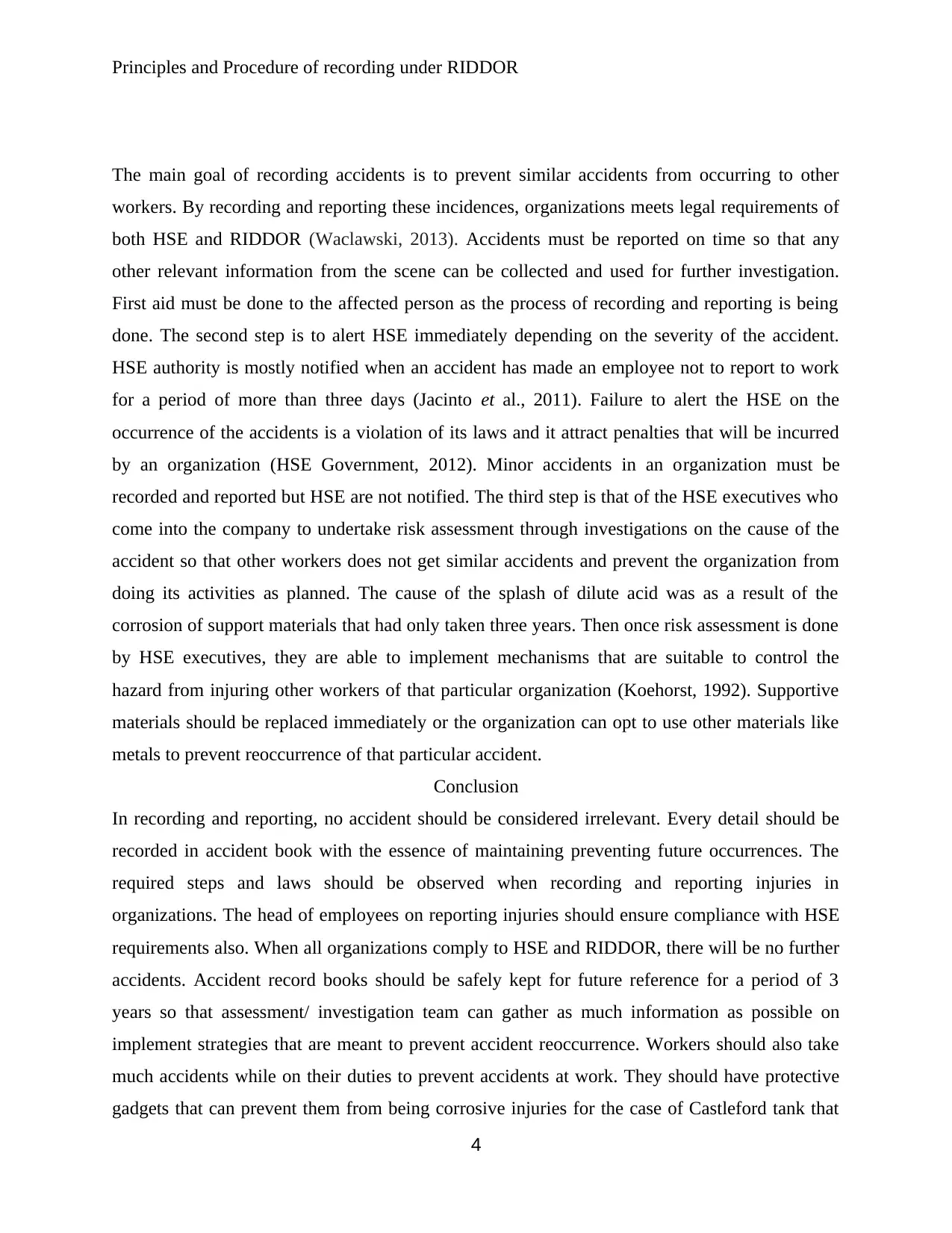
Principles and Procedure of recording under RIDDOR
The main goal of recording accidents is to prevent similar accidents from occurring to other
workers. By recording and reporting these incidences, organizations meets legal requirements of
both HSE and RIDDOR (Waclawski, 2013). Accidents must be reported on time so that any
other relevant information from the scene can be collected and used for further investigation.
First aid must be done to the affected person as the process of recording and reporting is being
done. The second step is to alert HSE immediately depending on the severity of the accident.
HSE authority is mostly notified when an accident has made an employee not to report to work
for a period of more than three days (Jacinto et al., 2011). Failure to alert the HSE on the
occurrence of the accidents is a violation of its laws and it attract penalties that will be incurred
by an organization (HSE Government, 2012). Minor accidents in an organization must be
recorded and reported but HSE are not notified. The third step is that of the HSE executives who
come into the company to undertake risk assessment through investigations on the cause of the
accident so that other workers does not get similar accidents and prevent the organization from
doing its activities as planned. The cause of the splash of dilute acid was as a result of the
corrosion of support materials that had only taken three years. Then once risk assessment is done
by HSE executives, they are able to implement mechanisms that are suitable to control the
hazard from injuring other workers of that particular organization (Koehorst, 1992). Supportive
materials should be replaced immediately or the organization can opt to use other materials like
metals to prevent reoccurrence of that particular accident.
Conclusion
In recording and reporting, no accident should be considered irrelevant. Every detail should be
recorded in accident book with the essence of maintaining preventing future occurrences. The
required steps and laws should be observed when recording and reporting injuries in
organizations. The head of employees on reporting injuries should ensure compliance with HSE
requirements also. When all organizations comply to HSE and RIDDOR, there will be no further
accidents. Accident record books should be safely kept for future reference for a period of 3
years so that assessment/ investigation team can gather as much information as possible on
implement strategies that are meant to prevent accident reoccurrence. Workers should also take
much accidents while on their duties to prevent accidents at work. They should have protective
gadgets that can prevent them from being corrosive injuries for the case of Castleford tank that
4
The main goal of recording accidents is to prevent similar accidents from occurring to other
workers. By recording and reporting these incidences, organizations meets legal requirements of
both HSE and RIDDOR (Waclawski, 2013). Accidents must be reported on time so that any
other relevant information from the scene can be collected and used for further investigation.
First aid must be done to the affected person as the process of recording and reporting is being
done. The second step is to alert HSE immediately depending on the severity of the accident.
HSE authority is mostly notified when an accident has made an employee not to report to work
for a period of more than three days (Jacinto et al., 2011). Failure to alert the HSE on the
occurrence of the accidents is a violation of its laws and it attract penalties that will be incurred
by an organization (HSE Government, 2012). Minor accidents in an organization must be
recorded and reported but HSE are not notified. The third step is that of the HSE executives who
come into the company to undertake risk assessment through investigations on the cause of the
accident so that other workers does not get similar accidents and prevent the organization from
doing its activities as planned. The cause of the splash of dilute acid was as a result of the
corrosion of support materials that had only taken three years. Then once risk assessment is done
by HSE executives, they are able to implement mechanisms that are suitable to control the
hazard from injuring other workers of that particular organization (Koehorst, 1992). Supportive
materials should be replaced immediately or the organization can opt to use other materials like
metals to prevent reoccurrence of that particular accident.
Conclusion
In recording and reporting, no accident should be considered irrelevant. Every detail should be
recorded in accident book with the essence of maintaining preventing future occurrences. The
required steps and laws should be observed when recording and reporting injuries in
organizations. The head of employees on reporting injuries should ensure compliance with HSE
requirements also. When all organizations comply to HSE and RIDDOR, there will be no further
accidents. Accident record books should be safely kept for future reference for a period of 3
years so that assessment/ investigation team can gather as much information as possible on
implement strategies that are meant to prevent accident reoccurrence. Workers should also take
much accidents while on their duties to prevent accidents at work. They should have protective
gadgets that can prevent them from being corrosive injuries for the case of Castleford tank that
4
Paraphrase This Document
Need a fresh take? Get an instant paraphrase of this document with our AI Paraphraser
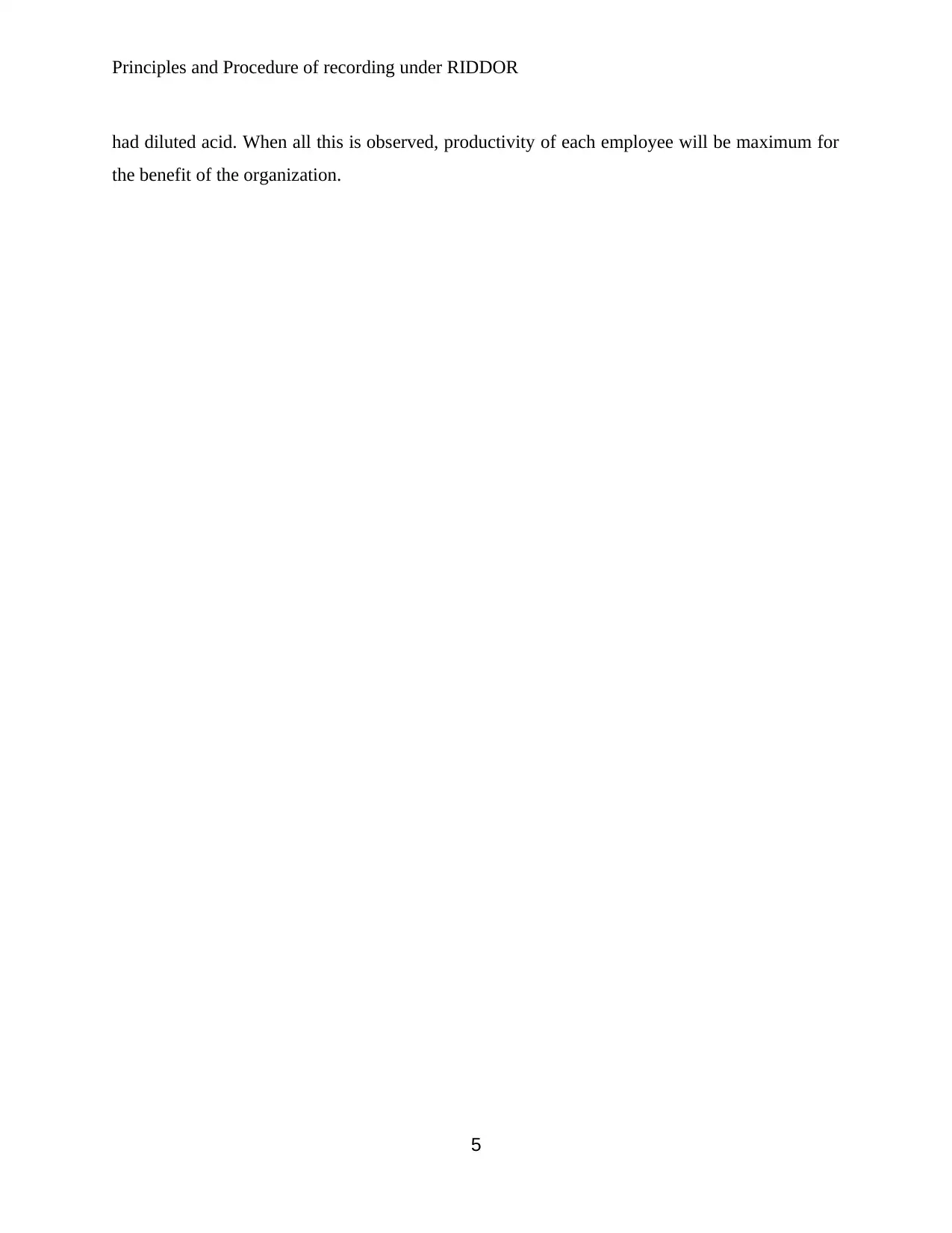
Principles and Procedure of recording under RIDDOR
had diluted acid. When all this is observed, productivity of each employee will be maximum for
the benefit of the organization.
5
had diluted acid. When all this is observed, productivity of each employee will be maximum for
the benefit of the organization.
5
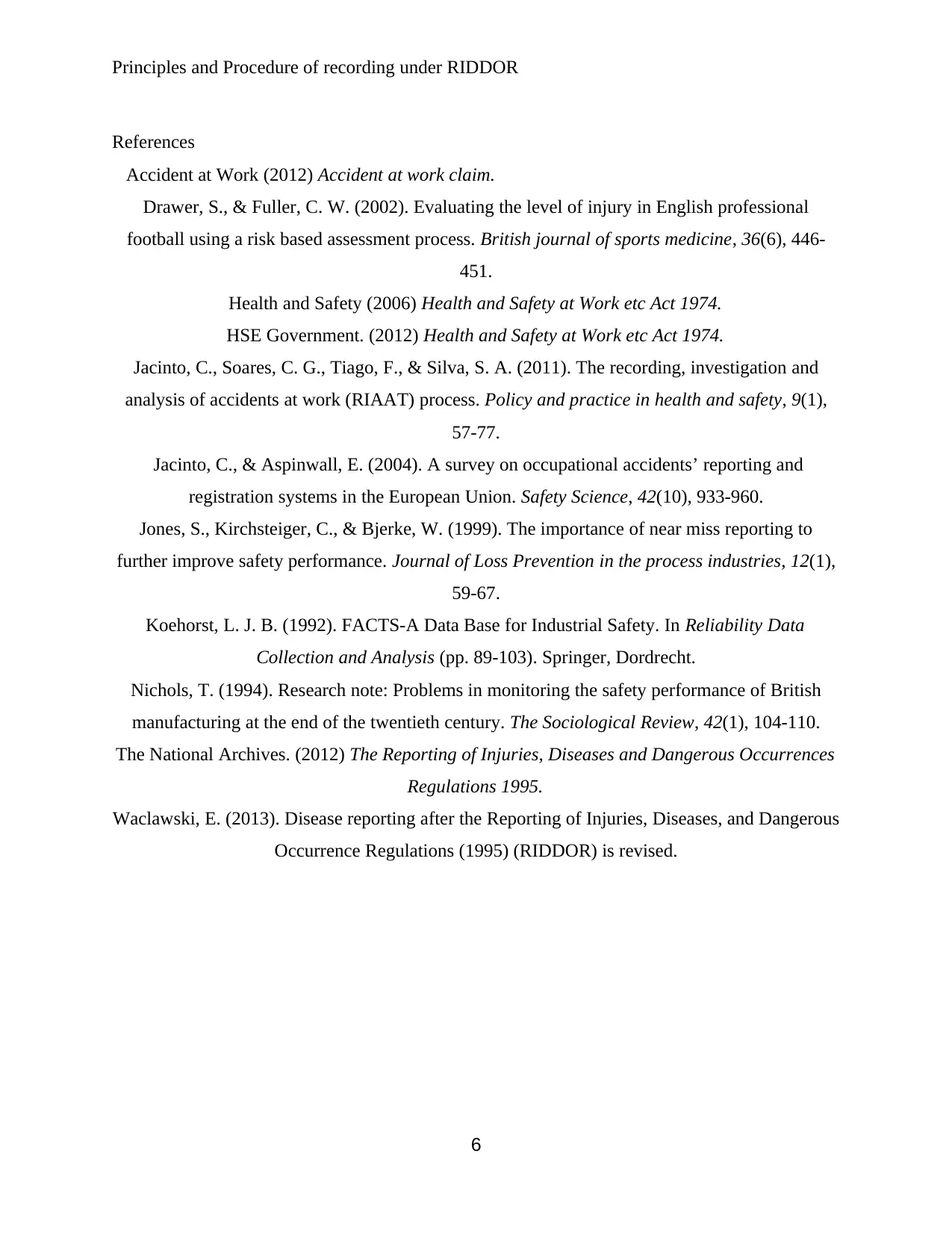
Principles and Procedure of recording under RIDDOR
References
Accident at Work (2012) Accident at work claim.
Drawer, S., & Fuller, C. W. (2002). Evaluating the level of injury in English professional
football using a risk based assessment process. British journal of sports medicine, 36(6), 446-
451.
Health and Safety (2006) Health and Safety at Work etc Act 1974.
HSE Government. (2012) Health and Safety at Work etc Act 1974.
Jacinto, C., Soares, C. G., Tiago, F., & Silva, S. A. (2011). The recording, investigation and
analysis of accidents at work (RIAAT) process. Policy and practice in health and safety, 9(1),
57-77.
Jacinto, C., & Aspinwall, E. (2004). A survey on occupational accidents’ reporting and
registration systems in the European Union. Safety Science, 42(10), 933-960.
Jones, S., Kirchsteiger, C., & Bjerke, W. (1999). The importance of near miss reporting to
further improve safety performance. Journal of Loss Prevention in the process industries, 12(1),
59-67.
Koehorst, L. J. B. (1992). FACTS-A Data Base for Industrial Safety. In Reliability Data
Collection and Analysis (pp. 89-103). Springer, Dordrecht.
Nichols, T. (1994). Research note: Problems in monitoring the safety performance of British
manufacturing at the end of the twentieth century. The Sociological Review, 42(1), 104-110.
The National Archives. (2012) The Reporting of Injuries, Diseases and Dangerous Occurrences
Regulations 1995.
Waclawski, E. (2013). Disease reporting after the Reporting of Injuries, Diseases, and Dangerous
Occurrence Regulations (1995) (RIDDOR) is revised.
6
References
Accident at Work (2012) Accident at work claim.
Drawer, S., & Fuller, C. W. (2002). Evaluating the level of injury in English professional
football using a risk based assessment process. British journal of sports medicine, 36(6), 446-
451.
Health and Safety (2006) Health and Safety at Work etc Act 1974.
HSE Government. (2012) Health and Safety at Work etc Act 1974.
Jacinto, C., Soares, C. G., Tiago, F., & Silva, S. A. (2011). The recording, investigation and
analysis of accidents at work (RIAAT) process. Policy and practice in health and safety, 9(1),
57-77.
Jacinto, C., & Aspinwall, E. (2004). A survey on occupational accidents’ reporting and
registration systems in the European Union. Safety Science, 42(10), 933-960.
Jones, S., Kirchsteiger, C., & Bjerke, W. (1999). The importance of near miss reporting to
further improve safety performance. Journal of Loss Prevention in the process industries, 12(1),
59-67.
Koehorst, L. J. B. (1992). FACTS-A Data Base for Industrial Safety. In Reliability Data
Collection and Analysis (pp. 89-103). Springer, Dordrecht.
Nichols, T. (1994). Research note: Problems in monitoring the safety performance of British
manufacturing at the end of the twentieth century. The Sociological Review, 42(1), 104-110.
The National Archives. (2012) The Reporting of Injuries, Diseases and Dangerous Occurrences
Regulations 1995.
Waclawski, E. (2013). Disease reporting after the Reporting of Injuries, Diseases, and Dangerous
Occurrence Regulations (1995) (RIDDOR) is revised.
6
⊘ This is a preview!⊘
Do you want full access?
Subscribe today to unlock all pages.

Trusted by 1+ million students worldwide
1 out of 6
Related Documents
Your All-in-One AI-Powered Toolkit for Academic Success.
+13062052269
info@desklib.com
Available 24*7 on WhatsApp / Email
![[object Object]](/_next/static/media/star-bottom.7253800d.svg)
Unlock your academic potential
Copyright © 2020–2025 A2Z Services. All Rights Reserved. Developed and managed by ZUCOL.




